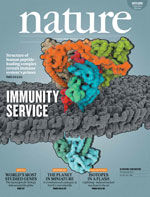News Archive
Structure of the human MHC-I peptide-loading complex
November 2017. The peptide-loading complex is a transient, multisubunit membrane complex in the endoplasmic reticulum that is essential for establishing a hierarchical immune response. This complex coordinates peptide translocation into the endoplasmic reticulum with loading and editing of the major histocompatibility complex class I (MHC-I). After final proofreading, stable peptide–MHC-I complexes are released to the cell surface to evoke a T-cell response against infected or malignant cells.
Sampling of different MHC-I variants requires the precise coordination of seven different subunits in a single macromolecular assembly, including the transporter associated with antigen processing (TAP1 and TAP2, jointly referred to as TAP), the oxidoreductase ERp57, the MHC-I heterodimer, and the chaperones tapasin and calreticulin. The molecular organization of and mechanistic events that take place in the peptide-loading complex are unknown owing to the heterogeneous composition and intrinsically dynamic nature of the complex.
A team of Frankfurt scientists has isolated human peptide-loading complex from lymphoma cells using an engineered viral inhibitor as bait and determined the structure of the native peptide-loading complex by electron cryo-microscopy. Two endoplasmic reticulum-resident editing modules composed of tapasin, calreticulin, ERp57, and MHC-I are centred around TAP in a pseudo-symmetric orientation. A multivalent chaperone network within and across the editing modules establishes the proofreading function at two lateral binding platforms for MHC-I molecules. The lectin-like domain of calreticulin senses the MHC-I glycan, whereas the P domain reaches over the MHC-I peptide-binding pocket towards ERp57.
This arrangement allows tapasin to facilitate peptide editing by clamping MHC-I. The translocation pathway of TAP opens out into a large endoplasmic reticulum lumenal cavity, confined by the membrane entry points of tapasin and MHC-I. Two lateral windows channel the antigenic peptides to MHC-I. Structures of the peptide-loading complex captured at distinct assembly states provide mechanistic insight into the recruitment and release of MHC-I. This study defines the molecular symbiosis of an ABC transporter and an endoplasmic reticulum chaperone network in MHC-I assembly and provides insight into the onset of the adaptive immune response.
Link to the research paper ...
Link to Nature News & Views article ...
Contacts:
Robert Tampé, Institute of Biochemistry, Riedberg Campus, Goethe University Frankfurt/M., Tel.: +49 (0)69 798-29475, tampe@em.uni-frankfurt.de
Arne Möller, Max Planck Institute of Biophysics, Frankfurt/M., Tel.: +49 (0)69 63033057, arne.moeller@biophys.mpg.de
Simon Trowitzsch, Institute of Biochemistry, Riedberg Campus, Tel.: +49 (0)69 798 29273, trowitzsch@biochem.uni-frankfurt.de
Publication:
Andreas Blees, Dovilė Janulienė, Tommy Hofmann, Nicole Koller, Carla Schmidt, Simon Trowitzsch, Arne Moeller & Robert Tampé: Structure of the human MHC-I peptide-loading complex. Nature, published online 6 November 2017 (First Release). doi:10.1038/nature24627. Link ...
Cluster of Excellence Macromolecular Complexes, Frankfurt am Main, Germany


